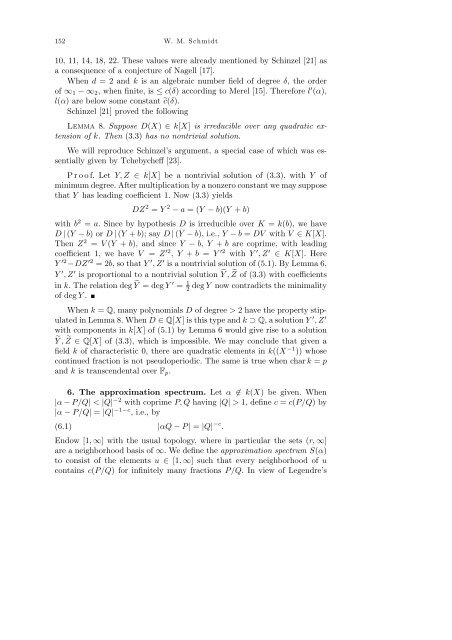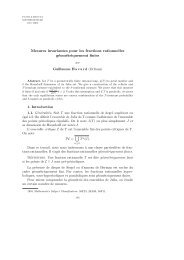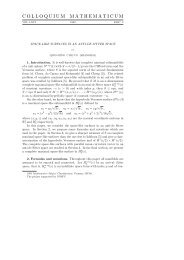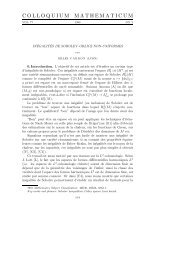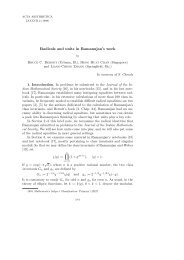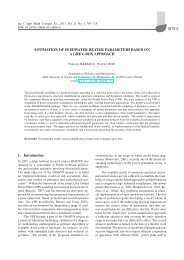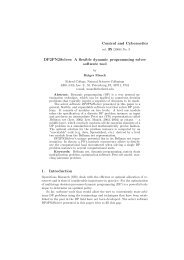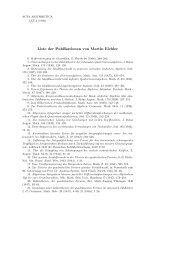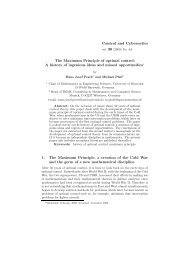On continued fractions and diophantine approximation in power ...
On continued fractions and diophantine approximation in power ...
On continued fractions and diophantine approximation in power ...
Create successful ePaper yourself
Turn your PDF publications into a flip-book with our unique Google optimized e-Paper software.
152 W. M. Schmidt<br />
10, 11, 14, 18, 22. These values were already mentioned by Sch<strong>in</strong>zel [21] as<br />
a consequence of a conjecture of Nagell [17].<br />
When d = 2 <strong>and</strong> k is an algebraic number field of degree δ, the order<br />
of ∞1 − ∞2, when f<strong>in</strong>ite, is ≤ c(δ) accord<strong>in</strong>g to Merel [15]. Therefore l ′ (α),<br />
l(α) are below some constant c(δ).<br />
Sch<strong>in</strong>zel [21] proved the follow<strong>in</strong>g<br />
Lemma 8. Suppose D(X) ∈ k[X] is irreducible over any quadratic extension<br />
of k. Then (3.3) has no nontrivial solution.<br />
We will reproduce Sch<strong>in</strong>zel’s argument, a special case of which was essentially<br />
given by Tchebycheff [23].<br />
P r o o f. Let Y, Z ∈ k[X] be a nontrivial solution of (3.3), with Y of<br />
m<strong>in</strong>imum degree. After multiplication by a nonzero constant we may suppose<br />
that Y has lead<strong>in</strong>g coefficient 1. Now (3.3) yields<br />
DZ 2 = Y 2 − a = (Y − b)(Y + b)<br />
with b2 = a. S<strong>in</strong>ce by hypothesis D is irreducible over K = k(b), we have<br />
D | (Y − b) or D | (Y + b); say D | (Y − b), i.e., Y − b = DV with V ∈ K[X].<br />
Then Z2 = V (Y + b), <strong>and</strong> s<strong>in</strong>ce Y − b, Y + b are coprime, with lead<strong>in</strong>g<br />
coefficient 1, we have V = Z ′2 , Y + b = Y ′2 with Y ′ , Z ′ ∈ K[X]. Here<br />
Y ′2−DZ ′2 = 2b, so that Y ′ , Z ′ is a nontrivial solution of (5.1). By Lemma 6,<br />
Y ′ , Z ′ is proportional to a nontrivial solution Y , Z of (3.3) with coefficients<br />
<strong>in</strong> k. The relation deg Y = deg Y ′ = 1<br />
2 deg Y now contradicts the m<strong>in</strong>imality<br />
of deg Y .<br />
When k = Q, many polynomials D of degree > 2 have the property stipulated<br />
<strong>in</strong> Lemma 8. When D ∈ Q[X] is this type <strong>and</strong> k ⊃ Q, a solution Y ′ , Z ′<br />
with components <strong>in</strong> k[X] of (5.1) by Lemma 6 would give rise to a solution<br />
Y , Z ∈ Q[X] of (3.3), which is impossible. We may conclude that given a<br />
field k of characteristic 0, there are quadratic elements <strong>in</strong> k((X −1 )) whose<br />
<strong>cont<strong>in</strong>ued</strong> fraction is not pseudoperiodic. The same is true when char k = p<br />
<strong>and</strong> k is transcendental over Fp.<br />
6. The <strong>approximation</strong> spectrum. Let α ∈ k(X) be given. When<br />
|α − P/Q| < |Q| −2 with coprime P, Q hav<strong>in</strong>g |Q| > 1, def<strong>in</strong>e c = c(P/Q) by<br />
|α − P/Q| = |Q| −1−c , i.e., by<br />
(6.1) |αQ − P | = |Q| −c .<br />
Endow [1, ∞] with the usual topology, where <strong>in</strong> particular the sets (r, ∞]<br />
are a neighborhood basis of ∞. We def<strong>in</strong>e the <strong>approximation</strong> spectrum S(α)<br />
to consist of the elements u ∈ [1, ∞] such that every neighborhood of u<br />
conta<strong>in</strong>s c(P/Q) for <strong>in</strong>f<strong>in</strong>itely many <strong>fractions</strong> P/Q. In view of Legendre’s


